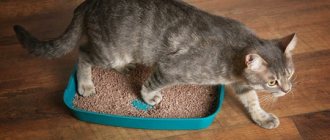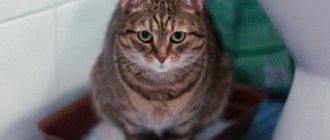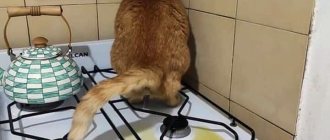Cats are clean animals, and they are also constant in their habits. In most cases, toilet training does not pose any serious difficulties.
But what to do if the kitten stubbornly ignores the litter box? What is the basis of this behavior, and how to fix it?
Mother teaches kitten
The first thing you should know: you cannot take a very small kitten from a cat, that is, younger than 1.5 months. Many large nurseries that care about the health and behavior of animals give away kittens after three months.
The fact is that in addition to feeding milk, a mother cat sets an example for her cubs on how to eat, how to hunt and protect themselves. But the most important thing for the owner is that the adult cat shows the cubs where to go to the toilet. This is why it can be difficult to immediately train a one-month-old kitten to the right place.
Kitten is stressed
Many cats react very nervously to any changes. They do not like moving, changing furniture, or repairs. They have a hard time with the arrival of new people in the house. For pets, having a baby can be stressful. In this case, you shouldn’t be surprised when puddles appear in unexpected places throughout the house. This only means that the kitten is stressed, he is marking his territory and defending himself. He should not be punished for this, but it is better to show him to the vet so that he can prescribe sedatives. This will help the cat recover and adapt to new living conditions.
- Author: Elena Romanenko
Rate this article:
- 5
- 4
- 3
- 2
- 1
(2 votes, average: 4.5 out of 5)
Share with your friends!
Bringing the kitten home
When the cub is separated from its mother and begins to live independently, it is taken to a new home.
Before you bring a kitten, you should first prepare everything:
- Buy a tray.
- Select and purchase filler.
- Buy a scoop for cleaning the tray.
- Choose a place for the toilet.
As soon as you bring the kitten into the house, place it in the litter box. To create the smell, you can take a napkin from the house where the kitten used to live, which was lying in the mother’s tray.
Show the kitten his toilet and let him get comfortable. The litter box must be in a secluded place so that the kitten feels comfortable and can do what he needs in silence and without distractions.
The next stage is to let the kitten get comfortable in the space. At the same time, he should not be frightened: nervous animals often have problems with training and adaptation. If the kitten gets scared, it may stop going to the litter box and it will be difficult to force it. The question of why a kitten doesn’t go to the toilet arises quite often, especially in the first months of its life in a new apartment.
In order for him to stop going to a place not intended for these purposes, you will have to make a little effort. In many ways, everything depends on the character of the pet and its intelligence, but occasionally there are cats that mark their territory. Usually this problem arises with the onset of puberty and there are other methods of solving it.
Perhaps the animal will learn on its own, but the owner will still have to help him and let him understand how to do it correctly.
The cat does not go to the litter box: what to do
A cat walking past the litter box is certainly one of the most unpleasant situations that can arise in a relationship with a pet. Some owners even, having tried everything, as it seems to them, to solve the problem and without achieving any results, decide to give the pet away. Unfortunately, there are many such cats in the Murkosha shelter. Most often, owners think that the cat is simply acting out of spite and this makes them even angrier. But in fact, a pet’s ignoring the litter box always has a rational reason, which is not so difficult to find and eliminate.
Problems with the toilet can be divided into two groups: the cat has stopped going to the litter box (although it used to use it regularly) or problems arise with accustoming the cat or kitten to the litter box.
1) The kitten does not go to the litter box in the new place
2) How to stop shitting in the wrong place
3) If the cat stops going to the litter box
The kitten does not go to the litter box in a new place
As soon as you bring a pet into your home, it doesn’t matter whether it’s an adult cat or a small kitten, it’s very important to immediately introduce it to the litter box. When the pet wants to go to the toilet (starts to fuss, sit down, run from corner to corner, as if looking for something), you need to take it to the litter box. When the animal relieves itself, it must be praised and given some kind of treat. Thanks to this, he will not only feel the love and care of his owner, but he will also develop a reflex: when you use the tray, they give him something tasty to eat and pet him.
Read more about litter box training: How to litter train an adult cat, How to litter train a kitten
It’s good if the cat understands everything the first time. But sometimes your pet may ignore the litter box at first. Below we have collected the most common reasons why this happens.
1. Inconvenient tray
The tray should be suitable for your pet in size and shape, and it should be comfortable to climb into. A tray that is too large may be inconvenient for a kitten; an adult cat will most likely refuse a small one, which she herself used while she was a kitten (due to its insufficient area). Trays with high sides are great for adults, but a kitten may find it difficult to climb into them. In general, choose a tray not “for growth”, but so that it is comfortable for your pet here and now.
2. Unpleasant filler
Sometimes a cat has nothing against the tray itself, but is not satisfied with the filler. For example, because it was different in its previous habitat. She may also be irritated by the smell of the litter or its texture. Try changing the filler. It is best to use the one that was familiar to the pet in its previous place. If you picked up a cat from the street, try sand instead of litter for the first time - this will remind the cat of its natural habitat. In the future, you can choose clay litter, since it is most similar to the soil to which such a cat is accustomed.
More information about the litter: What types of cat litter are there? Rating of the best cat litters All about absorbent cat litter All about silica gel cat litter Mineral cat litter: pros and cons All about clumping cat litter All about wood cat litter Cheap cat litter: pros and cons
3. Wrong place for the tray
Some owners believe that you can choose absolutely any place in the apartment for the cat litter box and the cat must meekly agree with this choice. This is mistake. Cats, with rare exceptions, will not relieve themselves in front of everyone. The place intended for the cat's toilet should be convenient, first of all, for the pet, and not for the owner. Otherwise, the cat will simply find such a place on its own, and it doesn’t matter whether the tray is there or not. Therefore, a space that is too open and where people often walk is not suitable. It is also absolutely unacceptable for there to be any constant noise or sharp sounds near the cat litter box - a washing machine, a faulty tap, etc. Cats prefer secluded, quiet, fairly dark places. The ideal option is a bathroom or toilet, or a closet, but only if there are not too many things there, otherwise the cat may begin to relieve itself on them rather than in the tray. A balcony is also suitable, but only if it is glazed and insulated - after all, a toilet is needed at any time of the year, and not just in summer.
You can trust the choice of place to the cat himself. Place several trays in different parts of the apartment. Most can be removed later when the pet chooses 1-2 places. Also, if you notice that the cat goes to a specific place, place the tray there too.
Important: there should be 1 more trays in the house than cats (for one - 2 trays, for two - 3, etc.). Some cats prefer to use different litter boxes.
4. Lack of free access to the tray
The cat should have free access to its toilet. Always. This means no closed doors if the tray is behind that door. This may not always be convenient. But otherwise, the cat, seeing a closed door, may decide that it is no longer possible to go there, and as a result, will be forced to find another place for the toilet.
5. Unpleasant associations
As we have already said, if a cat settles in the wrong place, you need to move it to the tray. But under no circumstances should you shout at him or behave aggressively. Otherwise, he will begin to associate screams and threats with the litter box. And cats diligently avoid everything with which they have unpleasant associations. In this case, you may need to not only change your behavior, but also move the tray to another location or even change it.
How to stop shitting in the wrong place
Thus, a convenient tray in a secluded place (but which is always accessible) and a familiar litter greatly simplifies the process of training a cat to use the tray. Using the advice of the Murkosha shelter team, you can avoid the most common problems with the litter box, which will have a positive impact on your relationship with your pet.
If a cat or kitten still manages to go to the wrong place, you need to (in addition to correcting the reasons for ignoring the litter box) do the following:
- thoroughly wash all places where the animal relieved itself with disinfectants;
- spray citrus spray in dirty corners;
- put food in the corner where the cat is used to shitting;
- place trays in places where the cat likes to relieve itself (when the animal chooses one tray, the rest can be removed).
Read more about fixing litter box problems: How to stop a kitten from pooping in the wrong place?
If the cat stops going to the litter box
It also happens that a cat regularly uses the tray for a long time, and then suddenly stops. Naturally, she has not forgotten what it is and why it is needed (with the exception of pets at a very advanced age). And as we mentioned, she doesn't do this to spite you. So instead of getting angry, we need to understand what has changed. Changes may be related to the litter box itself, to the cat, or to the situation around it.
1. The tray is no longer convenient
When the animal grows up, the size of the tray (which was purchased for the kitten) may be too small for it. In this case, you just need to buy a larger tray.
Read more about choosing a tray: What types of trays for cats are there and how to choose them correctly Tray-house for cats: what is it Tray with a grid: advantages and disadvantages Is it worth choosing an automatic tray for cats?
2. Dirt
Perhaps it's time to change the filler and rinse the tray thoroughly. Cats are very clean. Sometimes even dirt next to the tray can cause a refusal to use it. Often cats stop going to the litter box if the litter has not been changed for a long time and dirt, moisture, and excrement have accumulated in it.
It is worth changing the litter on average once every 2 days (if several cats use the litter box - every day). At least once every 2 weeks (if more than one cat uses the litter box - once a week), you need to wash the entire litter box. In this case, you will need to wash not only with warm water, but also use a mild detergent, or, alternatively, dishwashing detergent. In general, anything that does not leave behind a strong chemical smell will do. Cats are irritated by pungent odors; if this remains on the tray, your pet will almost certainly choose another place as a toilet. By the way, you can also wash the tray using a regular solution of baking soda and warm water.
3. New smells
This is why it is so important to use products that do not leave an odor when washing. Especially avoid using scented cleansers that smell like citrus. Cats simply hate this smell.
If the kitten stopped going to the litter box after the last cleaning, most likely this is the reason. It will help to rinse the tray again with plenty of water.
If you haven't used detergents or haven't cleaned recently, you may have switched to a new brand of litter (especially if it's aromatic) - so a new smell has appeared. It’s better to go back to the old, familiar filler.
4. Health problems
Sometimes cats walk past the litter box when they are sick or not feeling well. It is even possible that for one reason or another it is the trip to the litter box that causes pain. Because of this, the pet decides to stay away from him. In this case, you need to visit a veterinarian - only he will be able to make a diagnosis and prescribe (if necessary) a course of treatment. The tray design may also need to be replaced.
5. Stress
It also happens that something frightens a cat when it is doing its business in the litter box: a loud noise (in the apartment or on the street), a sharp scream or crying. Or the reason may be some drastic changes in the house - moving, changing the environment, the appearance of new people and animals. In general, a cat walks past the litter box because it is afraid, nervous, or simply depressed.
In these conditions, it is important to show the pet that he is still loved, that the home is still safe, and therefore there is no need to worry. By the way, cats tolerate stress more easily if they have their own private corner that belongs only to them (a house, a play complex, even just a place with a bed, preferably at a height), where they can hide and be in solitude and silence. You can also use medications to reduce stress levels, such as Feliway and catnip. Once the stress has passed, your pet should return to his normal habits, including using the litter box.
Read more about calming medications: How to calm an aggressive cat
As you can see, you can always find a reason why a kitten does not go to the litter box. Find and fix. Perhaps he needs the help of a veterinarian; he may need to replace the tray or filler, or even simply rearrange it or rinse it more thoroughly. In any case, some problems are not a reason to think about parting with your pet.
And if there is no cat in the house yet, you should think about getting one. And don’t think that it will be difficult to accustom your pet to the tray. If you do everything correctly and follow our recommendations, the probability of success will be close to 100%. In the end, you can take a kitten or an adult cat who is already familiar with the litter box. The Murkosha shelter will help you with this - all of our charges are trained to a tray and a scratching post, as well as vaccinated, have a veterinary passport and are ready to communicate with people.
Toilet training process
The little kitten goes to the toilet quite often and can't stand it. The owner will have to learn to determine when he wants to do his business. As soon as the baby begins to squat, he should be calmly transferred to the tray. If suddenly the kitten manages to make a puddle, it should be wiped with a strong odor-repellent agent.
A cat litter box without litter and with one mesh is, of course, convenient for the owner, it is easier to clean and no money is spent on it, however, it can be difficult to immediately accustom a kitten to the litter box for the reason that the cub does not understand what they want from him.
Under natural conditions, animals relieve themselves on the ground or in the sand, and then bury them. You can imitate natural conditions if you use bulk filler. The kitten will be happy to dig into it and this will help make it stop going to the toilet in other places.
Additionally, when the process of accustoming to a place occurs, you can use a special spray. Please note that there are two types of training aids:
- Repellent. They have a strong aroma and mask the smell in the place where the kitten went.
- Attractive. This spray is sprayed directly into the cat's litter box so that habituation in the apartment takes place as quickly as possible.
Usually, training a kitten to use a litter tray is not difficult. Cats are clean animals and get used to going to one place, but for the pet to get used to it quickly, this place must be comfortable.
Medical aspect
And we will immediately exclude such a special group as uncastrated animals . Everything is very clear here. The riot of sex hormones simply pushes these innocent poor fellows to “bad deeds.” High hormonal levels and the associated stress explain both puddles in the wrong places and vertical odorous marks left for the sexual partner. As a rule, miraculous castration solves all problems. If it does not help, then the problem moves from the medical category to behavioral, which we will discuss below.
If a castrated animal begins to walk past the potty, then the possible cause is some kind of internal disease, for example, hyperthyroidism (increased function of the thyroid gland), inflammation of the intestines, colitis, constipation, hepatitis, diabetes mellitus, food allergies, neurological disease. But the main role, of course, belongs to diseases of the genitourinary system, in particular, lesions of the lower urinary tract - cystitis, urolithiasis, etc.
In older cats, there is a decrease in both physical abilities (joint diseases, deterioration of vision and smell) and brain activity (memory deterioration, movement coordination, coordination of actions, etc.), which also does not contribute to the impeccable management of natural needs. Urinary incontinence can be caused, for example, by atony, an age-related weakening of the muscles of the urethra and bladder.
Thus, the main cause of cat uncleanliness may be pain during urination or defecation, or the inability to perform these functions correctly. Therefore, first of all, the disease causing this behavior should be identified and treated.
So, before punishing a pet for “bad deeds,” you should find out if he has a good reason for this. As usual, we go to the doctor and get a diagnosis. As a last resort, we at least take the urine for analysis (if the problem is “incorrect” urination). If the clinic actually confirms any disease, we apologize to the pet for thinking badly about it and begin treatment.
And if the stars are favorable, then after eliminating the problem the cat will return to its toilet. BUT! It is possible that the cat will “associate” its painful sensations with the litter box, and the aversion to it will be fixed in its mind for a long time. That is, the medical aspect of the problem will degenerate into a behavioral one.
It should be noted that even if the doctor did not find physiological abnormalities in the pet, this does not mean that they actually do not exist. Maybe I really didn’t find it.
Training errors
If your kitten does not go to the toilet, this may happen for the following reasons:
- The tray is not convenient enough.
- The animal was scared in the place where the tray was installed.
- The kitten was taken too early, and the mother cat did not have time to teach her to go to the litter box on her own.
- The animal has health problems, so it does not have time to reach the place.
If a kitten does not go to the toilet, this problem must be corrected as quickly as possible: the main character traits are formed in childhood, and it will be more difficult to retrain later. The owner must be persistent, but at the same time gentle, so as not to scare the small pet.
Hygiene needs to be paid attention from the very first days of the animal’s appearance in the apartment. The spray is an excellent tool if you need to wean off marks and change your pet's behavior when the kitten does not go to the toilet.
Useful tips
- If your cat begins to shit in another place, then do not be lazy and install a new tray there with the same filler.
- When the cat starts using the toilet again, she will need to be praised. Therefore, when she is raking in her dark deeds, then come up and pet her.
- If your pet begins to relieve itself on the bed, then you need to cover it with plastic wrap. You need to glue double-sided tape on top, in this case the cat’s paws will stick, and he definitely won’t like it. Soon he will forget about your bed, as it will cause him discomfort.
Be patient and attentive to your pet, in this case you can achieve the desired result. We wish you success in everything!
Preventing constipation in a kitten
Constipation in pets is no less dangerous than diarrhea, especially for pets who are not yet two months old. It is not enough to bring home a kitten; you also need to provide it with food in accordance with its age and adapt it to adult life. To make the process of getting used to food go smoothly, you need to follow the basic rules that will help prevent constipation:
- purchase toys so that your pet can move more and quickly adapt to a new place;
- correctly create a diet, include meat products and vegetables in it;
- periodically give your pet fermented milk products;
- when feeding finished products, it is better to give preference to premium food intended for kittens;
- Clean the tray regularly;
- carry out deworming in a timely manner;
- comb the baby so that he does not swallow a large amount of hair when licking;
- remove all small objects that the pet can accidentally swallow during play;
- Periodically visit a veterinary clinic for preventive examinations and vaccinations.
Sources:
https://koshek.ru/kotenok-ne-mozhet-sxodit-v-tualet.html https://zverki.click/koshki/uhod-koshki/problema-s-kotenkom-kotoryy-ne-hodit-v-tualet -po-bolshomu.html https://murkoshka.ru/kotenok-doma/zapor-u-kotenka.html
Psychological reasons
This group includes any factors affecting the psychological state of the animal. In addition to severe stress and other emotional turmoil, an unfamiliar smell can cause a dislike of the bathroom.
Didn't like the new tray or filler
If you recently changed the tray to a different model, then most likely it’s all about the strong smell of plastic and the absence of cat marks. Also, the pet may be confused by the appearance of the product if the purchased toilet is fundamentally different from its previous version.
Associated symptoms of urinary retention
Untimely urine flow can be very dangerous for a cat's life. Due to urinary retention, the body is at risk of intoxication, and the bladder may simply not withstand the strain. The following symptoms indicate urinary retention:
- plaintive meowing while going to the toilet;
- a sudden change in the smell, consistency or color of urine;
- strong thirst;
- loss of appetite;
- restless behavior;
- temperature increase;
- the appearance of pus, blood or other inclusions in the tray;
- frequent licking of the genitals;
- weakness;
- pain and tension of the abdomen on palpation;
- prolonged and unsuccessful attempts to pee;
- tucking or, conversely, unusual stretching of the hind limbs;
- reluctance to sit in the owner's arms.
The appearance of several symptoms of urinary retention in a kitten is a reason for a mandatory visit to a doctor in order to make a diagnosis and prescribe the necessary treatment.
Diagnostics
When contacting a veterinary clinic to determine the causes of urinary retention, the doctor will definitely carry out the following manipulations:
- Visual inspection. When examining a kitten's abdomen, the veterinarian will certainly notice a full and painful bladder. When pressing on it, urine usually does not come out. If urinary retention has been observed for a long time, an examination may reveal symptoms of kidney damage: the smell of ammonia from the breath, decreased capillary refill rate, hypothermia, decreased heart rate. Also, cats may have a swollen genital organ due to constant trauma from licking.
- Ultrasound of the bladder usually reveals its fullness and the presence of suspension in it. Kittens also undergo an ultrasound of the kidneys to exclude their involvement in the inflammatory process.
- An X-ray of the abdominal organs is performed to find out how much damage the kitten's kidneys and urinary system have suffered.
- Biochemical and clinical blood tests show the condition of the liver and the level of intoxication in the body.
- A clinical urine test is necessary to detect bacteria and traces of blood in it.
- Sometimes cats are given an ECG to detect the toxic effects of high potassium levels on the heart muscle.
Kitten can't go to the toilet
Until the kitten is one month old, the mother cat stimulates the process of defecation by licking. By the end of the 4th week of life, the baby’s intestines are formed, the diet becomes more varied, and feces are formed. The kitten goes to the toilet on its own 2-3 times a day.
After one year of age, the animal defecates 1-2 times daily. If this does not happen, it means that the pet is developing a gastrointestinal disease or other pathology. Intoxication begins, the kitten becomes dull, hair falls out, and the skin becomes covered with a rash. Peristalsis is affected by the kitten's nutrition, activity, and a number of diseases.
Treatment Options
The main task of the veterinarian in case of urinary retention in a kitten is to remove the blockage and restore the flow of urine. The veterinarian may apply gentle pressure to the bladder and help the animal urinate. If after such manipulation the kitten cannot pee, he will be prescribed conservative or surgical treatment depending on the severity of the condition.
Conservative (Catheterization)
Catheterization removes accumulated fluid and flushes the plug from the urinary tract into the bladder. This procedure is quite painful, so it is performed under local or general anesthesia. The catheter is usually left in place for a couple of days.
Kittens that have had urinary retention for 1–2 days or more are most often left in the hospital hospital for 2 days to monitor their condition. Then, to identify the reasons that led to this problem, the animal’s urine and blood are taken for analysis and an ultrasound is performed.
After normalization of urine outflow, its formation should be monitored for several days if its amount per hour is lower or higher than normal values (2–4 ml/kg/hour).
The following drugs are also administered subcutaneously or intravenously to kittens:
- antibacterial;
- painkillers;
- hormonal;
- antihistamines;
- diuretics;
- antispasmodics;
- dehydration solutions;
- sorbents.
After 2 days, the catheter is removed and the kitten is observed to pee. At first, urination will be painful and difficult, but later it will return to normal.
Surgical
In the most severe cases, when catheterization cannot be performed due to severe blockage, and also if it is repeated repeatedly, the kitten undergoes a perineal urethrostomy. During this emergency surgery, the animal's penis and testes are removed, and then a shorter, wider urethra is created, like a female's.
Perineal urethrostomy does not prevent or cure urinary tract diseases, but only helps to avoid blockage of the urethra.
For 5–7 days after the operation, the patency of the urethra and the correct formation of the new opening are checked daily. Also, the kitten must be prescribed antibiotics, and the sutures are removed only after complete healing of the wound and normal functioning of the newly formed urethra.
Important! During the entire period of healing of the sutures, the kitten must be in a protective collar and diaper, since licking the wound threatens to re-stitch it.











